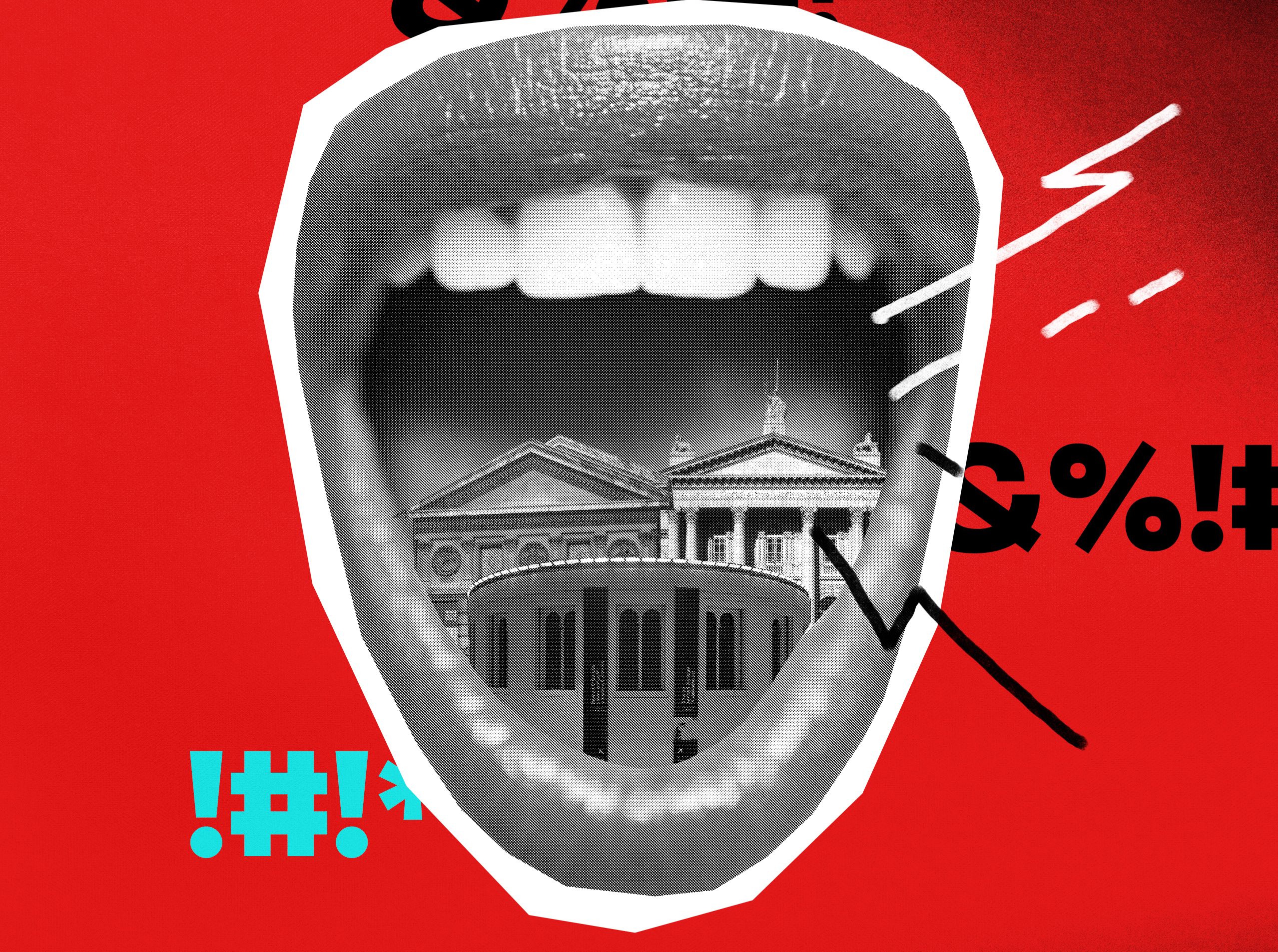If you’re asked what words you associate with tour guiding, the terms “disruptive” or “subversive” are most likely not the first to come to mind. For most people, the world of art galleries and museums is something firmly tied to the past and to the establishment, the domain of field trips and tiring family vacations.
Alice Procter is challenging that. Taking crowds of tourists around the packed museums of England’s biggest and most diverse city, 23-year-old Procter initially seems, in her own words, like “like every other nice little white girl tour guide with an art history degree.” But she’s not.
Procter runs Uncomfortable Art tours in London, tours that have got a lot of attention recently for showing a side of art that most tour guides don’t. The tours are based in some of the most renowned art museums in the UK: the National Gallery, the National Portrait Gallery, the British Museum, the Victoria & Albert, Queen’s House and the Tate Britain. However, Procter isn’t employed by these galleries — she simply uses the spaces, which, being nationally owned, have policies to let people run independent tours.
Procter regularly shows guests around these nationally and internationally famous venues — buildings that house works by Leonardo Da Vinci, Vincent Van Gogh and Edvard Munch, not to mention artifacts like the Rosetta Stone and Egyptian mummies — but she has no time for reverence. “These institutions aren’t sacred and they shouldn’t be sacred,” she says.
Instead, Procter’s tours reveal the dark underside of famous and iconic art. She sees physical pieces of art as not just having aesthetic value but also reflecting and coming from their specific historical context.
Starting at the late Tudor period in the 1500s and working up to the Victorian period in the 1800s, she explores the galleries’ pieces by putting them into the context of the British Empire and historical systems of oppression. She looks specifically at the period from the beginning of the British slave trade and the powerful East India Company, to the dissolution of both in the 19th century.
For instance, she contextualizes Elizabethan art by explaining that Queen Elizabeth I, the British “Virgin Queen” whom the state of Virginia was named after, presided over the beginning of Britain’s slave trade. It’s a part of history that many Brits themselves aren’t aware of, and isn’t usually taught in-depth in schools. So Procter has taken it upon herself to fill in the gaps and make this history less abstract, showing how it’s interconnected with Britain’s art and culture. She argues that it would be dishonest — telling an incomplete story — to leave this history out when teaching about the art of that period.
Uncomfortable Art tours are arguably particularly relevant and important right now. Procter says that she happened to have “caught a wave of questioning and fear and confusion” in the context of an international political shift, with Brexit on one side of the Atlantic and Trump on the other. This “wave” might be partly responsible for how receptive the public has been to Uncomfortable Art tours so far; Procter only started the project in mid 2017, and it’s since blown up, providing a refreshing, unique and increasingly popular take on art tourism.
The motto of Uncomfortable Art tours is “Display it Like You Stole it,” which Procter sells on stickers and has encouraged to become a hashtag on Twitter, explaining the phrase as a call for museums to rethink the politics of display on her website. She argues that many works on display in Britain were acquired through imperialism, something that museums don’t make clear.
This is a hot-button issue in the world of museums, and has been for some time. In 2015, activists protested the British Museum possessing and displaying Indigenous Australian items. The debate over repatriation is constantly raging, and not by any means just in the UK — for instance, there have been recent calls for Germany to return a bust of Nefertiti to Egypt. Even human bodies aren’t immune to museum’s colonial practices: the dead corpse of black South African woman Saartjie Baartman, displayed as a “freak” in Europe in the 1800s, was on display in Paris until 1974.
An article from the Independent argues that museums in Britain have partaken in a “colonial cultural massacre of sorts” through their collecting of other countries’ histories. The exhibits of the British Museum, where Procter conducts tours, include Egyptian, Aztec and Easter Island artifacts gained during the colonial period.
Procter is clearly on a political mission to bring attention to these hidden histories and modern injustices — but why does she choose to spread her message in the form of guided tours? For the Australian-born Procter, art has always been important and present in her life. “My parents would take me to exhibitions and museums from when I was literally a babe in arms,” she says. “I’ve always just been at home in museums and been super interested in them as spaces for storytelling.” She has also always been keenly aware of imperial history: her parents taught her about how she “would literally not exist” were it not for the colonization of Australia.
At school, Procter was interested in pursuing art, but after struggling in art class a teacher took her aside and explained that she could engage with it without actually having to be an artist. In high school, she took art history at A-level (the pre-university qualifications that encompass the last two years of school in the UK) and volunteered at art galleries at the same time. “I started volunteering to get out of sports, which is a classic kind of accidentally found my career story,” she laughs. She then went on to do her bachelor’s degree in art history at University College London.
Yet Procter found some elements of art history frustrating. She found there was a pressure to be talking about aesthetics, when she wanted to explore the politics and ideology behind art. She didn’t “just want to look at paintings.” So when Procter set up her own tours, she took a different approach. “I was talking to some friends about the fact that I wanted to start running these tours and what they said was, ‘So basically you want to take people into art galleries and make them feel really really awkward.’ Yeah, that’s kind of the point,” she explains. “If you’re in a museum saying, ‘Well, let’s talk about the violence embedded here,’ you can kind of occupy the space in a different way and it also becomes activist work … it’s not just academia in a bubble.”
Procter’s work is making a lot of waves. She has an ambivalent relationship with museums and galleries, who she says aren’t always too fond of her — plus they now all know who she is, making things more awkward — but they also recognize that her work fills in gaps that they haven’t managed to fill, and that she brings in an audience who want to approach the exhibits in a different way.
Her guests certainly seem to appreciate her work, going off the reviews on her Facebook page. Twenty-five-year old Lydia Smith was recently one such guest on an Uncomfortable Art tour. She says that she “wanted a different perspective” and that she “learnt so much, more than I’d expected…we were encouraged by Alice as a group to ask lots of questions.” One of the things Smith learned was that taxpayer compensation for slave owners “was only paid off by the government in 2011, meaning I have paid taxes that covered the losses of slave owners.”
Of course, not everyone has such a favorable view of Procter’s tours, which remain controversial. Maybe the biggest backlash to Uncomfortable Art tours stemmed from the publicity she gained after British newspaper the Daily Mail catapulted her into a moment of semi-fame, publishing an article about her with the headline “Art historian, 23, and museum guide is using sell-out tours to label Lord Nelson a ‘white supremacist’ and brand Queen Victoria a ‘thief.’”
The article pointed out that a historian and Member of Parliament had called Procter’s tours “babyish.” Comments largely disagreed with her take on history, and she says she woke up the day the article was published to an email saying that “I should leave the country before someone did the right thing and killed me.”
However, Procter is adamant that she would much rather alienate her critics than to stay quiet about what she sees as the silencing of minority groups within the art world and the obscuring of dark truths behind British culture. “It made me realize that I have a kind of public profile in a way that I would never considered before,” she says, adding, “There’s always someone who’s going to dislike what you’re doing.”
In fact, that moment was something of a turning-point for her; she decided to stop playing nice with museums and appeasing those who disagree with her message. She jokes that she was “radicalized” by the backlash she received and realized that she can’t please everyone; she now takes an approach of “if you’re not here for it, you’re not here for it.”
It’s not just the conversation around art pieces themselves that Procter wants to change either, though. She also wants to lift the lid of how museums are run and open up a dialogue around their purpose, asking how art venues function and what they teach.
She takes a firm stance on museums: “This is an activist project, and I’m not here to support institutions.” She argues that as state-run, free-entry spaces — as most of the famous London galleries are — they present themselves as impartial, objective fountains of knowledge. But “official” knowledge isn’t always untainted by ideology.
Procter also argues that art conferences and panels on the future of museums are simply too expensive to be accessible to the vast majority of people; not to mention that a disproportionate amount take place in the UK and coastal U.S., excluding the majority of the world. She also takes a stand against what she calls “tokenism” and “box tick … diversity,” that she argues lets museums and art spaces appear progressive while simply recruiting minority communities for unpaid work.
She certainly takes no prisoners — and so far her method is achieving success, or at least fueling an important debate. Her tours, as well as her other projects, are becoming more and more known, sparking conversation and reflection in the art world and beyond. So what’s next for her?
“I need to take the tours outside London,” she says. “The problem is that right now it’s just me … everything is currently just run from my kitchen.”
That could change, though. Procter is already leaving the “London bubble” by teaching a class in Philadelphia later this month. She has a podcast — humorously named “The Exhibitionist” — and is considering pursuing a doctorate degree. She’s even writing a book, focusing on colonialism and institutions of art and history. It’s a lot to juggle for anyone, let alone a 23-year-old also working part-time on a master’s degree.
In the meantime, though, Procter will continue working out of her kitchen to fix the art world. “I want to give people the sort of critical toolkit to engage in this in their own ways,” she says. “I want a reconsideration of what museums are for and I want the institutions to do some navel gazing and think about what their actual purpose is, because it’s not just about protecting objects, it’s about telling stories and representing communities and representing experiences.”
One thing’s definitely clear: the future of how we approach the past is going to be different, and Alice Procter, armed with art history knowledge and anger, will undoubtedly be a part of shaping that future.
Procter has a website, Facebook page, Twitter account and podcast.

















